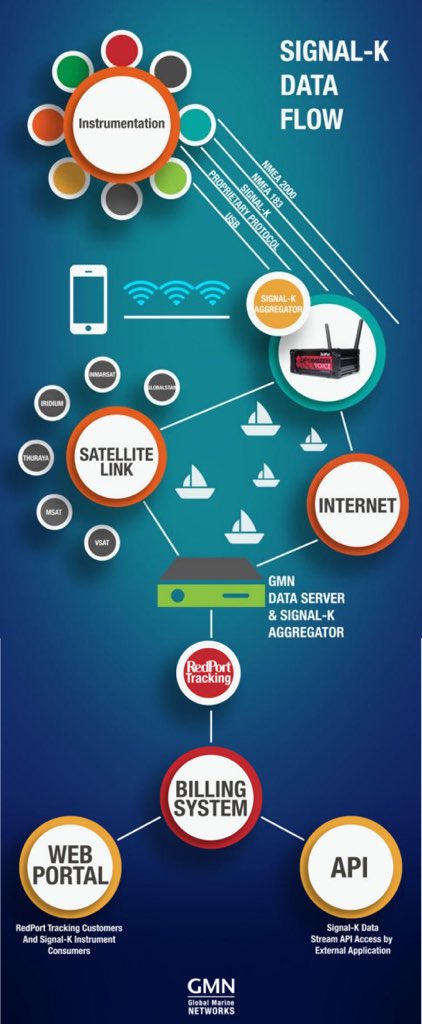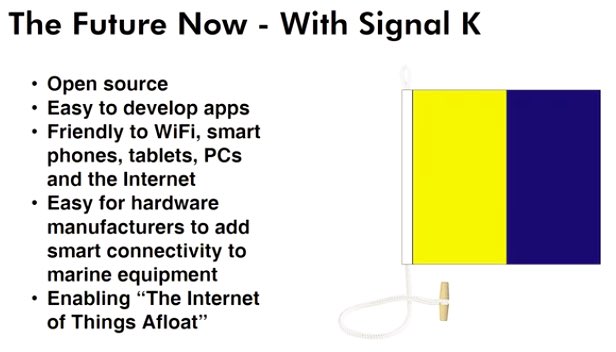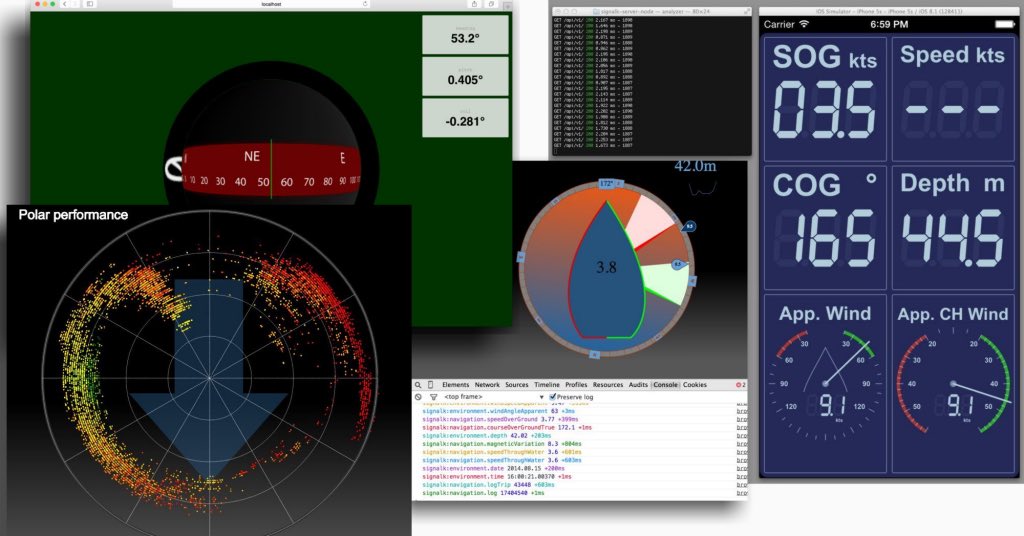You will soon hear about Signal K, a marine data communication standard, developed in open source, which aims to replace NMEA standards (0183 and 2000) technically overwhelmed by the exponential development of connected objects. The designers intend to provide an open and free protocol to developers and manufacturers alike., allowing to get over the constraints linked to the NMEA : license costs, flow limits, limit the number and type of devices, unsuitability for complex environments, to wireless communications, therefore incompatible with the Internet of Things and the Internet itself.
 Some manufacturers, as Nick Heyes, CEO Digital Yacht, have not hesitated to follow in the footsteps of the project. Digital Yacht has launched the design of an NMEA gateway to Signal K, iKommunicate, by raising funds through a call for collaborative financing via KickStarter. Other well known actors like Luis Soltero, to Global Marine Network and RedPort, or Jeff Siegel, founder of Active Captain (the most important community nautical database), embraced the project with enthusiasm. There is no doubt that this should quickly create a following and boost the project. (¹).
Some manufacturers, as Nick Heyes, CEO Digital Yacht, have not hesitated to follow in the footsteps of the project. Digital Yacht has launched the design of an NMEA gateway to Signal K, iKommunicate, by raising funds through a call for collaborative financing via KickStarter. Other well known actors like Luis Soltero, to Global Marine Network and RedPort, or Jeff Siegel, founder of Active Captain (the most important community nautical database), embraced the project with enthusiasm. There is no doubt that this should quickly create a following and boost the project. (¹).
In addition, the National Marine Electronics Association (²) who publishes NMEA standards, acknowledged the project last May and gave it its support.
It remains to discover how the major marine electronics manufacturers will react, Furuno, Raymarine, Garmin, Simrad, Nobeltec, who have made significant investments in NMEA, especially NMEA2000, which cost them a fortune in operating licenses. (¹).
I give you hereafter the in-extenso translation of the presentation on the website of the project :
Signal K is the publication of a common, modern open data standard for marine use. A standard for modern boats, compatible with NMEA, Wi-Fi friendly, to smartphones, to tablets and the Internet. A format accessible to all, for which everyone can contribute.
Introduction
K signal is to be the next generation solution for the exchange of marine data. It is intended to be used not only for the communication between the instruments and sensors on board a single vessel, but also to allow data sharing between several boats, navigation aids, bridges and marinas. It is designed to be easily implemented by web and mobile applications and to connect to modern boats Internet of Things.
Justification
There is a need for a new communication protocol for maritime industry to meet the needs of a changing world and increasingly interconnected. The currently most widely deployed mechanism for interconnecting instrumentation has been with us for over thirty years. Unlike other ubiquitous communication protocols in the same period, NMEA 0183 has not aged as well. This has been recognized since 1994 when a replacement development began, the NMEA protocol 2000. Unfortunately, by the time this replacement hit the market early in 2001, he was already showing his age. Fourteen years later, it is clear that a new forward-thinking approach is needed.
There are several major problems with existing standards. By breaking down, the first problems are technical. Both standards are basically serial LANs designed for limited deployments in simple environments. NMEA 0183 is limited up to 4800 bauds (115.200 bps maximum, which saw deployment limited to AIS instruments) and a single transmitter device. NMEA 2000 operates at a significantly higher throughput (250 kbps) and allows multiple devices to transmit on a shared bus, but it is limited to 50 devices on the bus. These decisions may have been perfectly rational, twenty or thirty years ago, but today, we need something more performant and extensible.
The next major problem is not technical, but rather a legal question. These standards are published and available for use by developers. However, although they are open standards and that everyone can develop a product using it, the two are not for free, in that their use is governed by a license agreement which limits the way in which they can be used and, in the case of NMEA 2000, a non-disclosure agreement. A substance, this prevents the diffusion of an open source application developed using these standards.
Finally, and above all, both NMEA standards and other proprietary protocols in the industry were developed when the instruments on board medium-sized boats were much simpler and less efficient. In a world where the thermostat in your home is connected to Internet and the number of Internet-connected devices in the US alone is expected to exceed one billion by 2016, it seems archaic that your boat is still an isolated island itself.
After all, your boat is not alone on the sea. There are many others, and also many other information sources . In the modern connected world, shouldn't you be able to access this information from your boat wherever you are and whatever device you are using ? To move forward, we need to think in a connected way, with a fundamentally different way from the NMEA protocols. Sun Microsystems is famous for inventing the sentence "The network is the computer", and Signal K reflects this global peer-to-peer concept."
In its concept, the Signal K standard will make it possible to manufacture future navigation devices capable of communicating beyond the simple on-board cable, via Wi-Fi, Bluetooth, through Internet, without need for costly gateways or specific applications. Navigation data can be saved and shared on the cloud, information can flow between ships, and between land and ships. Harbor master's office will be able to provide useful real-time information to ships that access it, immediately displayed on the chartplotters, such as authorized or prohibited anchorage areas, in example. And many other services can be developed.
Perhaps a milestone for marine electronics, the entrance of boating in the third millennium. let's wait and see…
———
(¹) Source : Panbo
(²) See NMEA in the Cartographic and maritime glossary
———




Excellent news, hoping that the big brands won't drag their feet too much, even if Julien's remark is correct… we have already seen major players disappear at a poorly negotiated turn !
In the history of technology, open standards have always prevailed over closed standards. Institutional actors will undoubtedly build resilience, but technological change will impose itself.
This technology will undoubtedly see the emergence of new players, to the detriment of big brands….